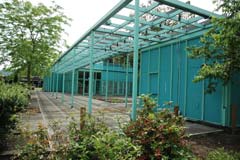
by John Yeon, has architectural significance.
(Photos � J. Maus)
Negotiations between a private developer and the Portland Parks bureau that would have created a new bike services facility and cafe at the former Tom McCalls restaurant site in Waterfront Park, have ended.
The Oregonian reported a few hours ago that negotiations between Bike Republic — a company founded by Ken Nichols to create full-service bike commuter facilities — and the bureau have “fallen apart”.
According to both a representative at the parks bureau and Ken Nichols, the deal went south primarily because Laughing Planet Cafe, expected to be an anchor tenant in the development, pulled out of the project late in the negotiations.
“The big dent in our proposal was Laughing Planet leaving at the end,” Nichols told me via telephone this morning. Nichols said time ran out and he was not able to put together the right mix of tenants that would have resulted in the financial return required to pay the lease terms set by the parks bureau.
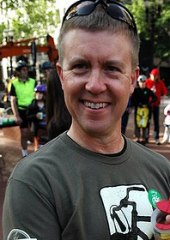
“Even with Laughing Planet there,” he said, “it’s debatable we would have reached an agreement with the City…but I think we would have gotten their with Laughing Planet.” Nichols said the the cafe portion of the development was 3/4 of the revenue and that, “It’s hard to deal without that.”
Richard Satnick, the founder of Laughing Planet, said he and his two other partners decided to pull out because the plans — which he says changed significantly from when negotiations first started — didn’t fit their core business model.
“Ken had to scale back his plans so much that it was not the original world-class bicycling hub we though we were getting into.”
–Richard Satnick, Laughing Planet Cafe
On the phone this morning, Satnick said “It was a tough decision for us,” and that he is “sorry that it’s not going to go forward.” Satnick admitted that he was a bit over-excited about the project initially. “I bought into the original vision too hard. I was excited about building a world-class bike facility on the Waterfront.” But, he said, once his partners started to ask hard questions about it, they realized it was “just too complicated and too risky”.
(Satnick also added that looming enonomic uncertainty made him even less likely to commit and that in hindsight, he should have taken more notice of Bike Gallery owner Jay Graves, who opted out of the project months ago.)
That “original vision” by Nichols was to create a full-service “bike hub” at the location that would have included bike repair, a small bike shop, parking, and other bike commuter amenties along with a bike rental operation and a cafe.
However, both Satnick and Nichols expressed frustration that the plans were ultimately whittled down to just bike rentals and a cafe. And that, they say, is the doing of the parks bureau.
“I think parks has a fair share of responsibility in this,” said Satnick, “they were unwilling to let Ken do a lot of work to make the site into something really special. Ken had to scale back his plans so much that it was not the original world-class bicycling hub we though we were getting into.”
Nichols concurs, and said that by the end of the negotiations, the cafe would have been on the hook to generate 3/4 of the revenue. Nichols laid less blame on the parks bureau but did say that it was “very difficult” to do the bike amenities part of the project because “the City made it difficult to add to the site.”
Nichols said adding the bike-specific amenities to the project (anchored by a small bike repair and retail shop) would have required an investment that he couldn’t recoup under the terms of the City’s lease.
Todd Lofgren, the business development coordinator for the parks bureau said it just came down to “trying to figure out how to make the finances work” and that the parties “weren’t able to come to terms.”
Lofgren says they’re canceling the existing RFP to develop the site but that that “doesn’t mean Ken or others can’t come back to us to try and make something work”.
But Nichols seems unlikely to try again. He told me that once he realized the bike commuter infrastructure side of the project wouldn’t happen, he lost his “passion for this location”. Now he’ll look to other locations (he’s got two already in the pipeline) where his Bike Republic concept can find a home.
In the end, Satnick said it’s, “unfortunate that Ken gets caught holding the bag. His idea that was proposed was very exciting and it would have worked very well.”


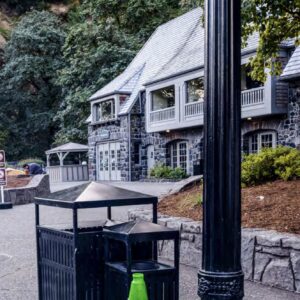
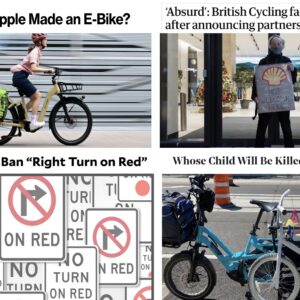
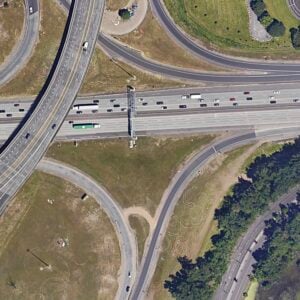
Thanks for reading.
BikePortland has served this community with independent community journalism since 2005. We rely on subscriptions from readers like you to survive. Your financial support is vital in keeping this valuable resource alive and well.
Please subscribe today to strengthen and expand our work.
Jonathan,
An accurate account. I would add the following.
I have spent a year considering what works and what doesn’t at this site. A low-car program can work. Bike rentals and visitor information at the site remain intact and viable. I believe we were a cafe operator away from activating this site. A cafe would print money at this location May through September, and need to be creative in winter months. Among the ideas in the winter were bike delivery and free-tune ups.
Depsite the slight bitter taste in my mouth, I remain interested in restoring this historic landmark and activating the site for Portlanders and park visitors. The Bike Republic investment objectives, and need-no-car program remain intact. I will continue to talk with interested cafe operators, and will consider future transactions that make sense for Bike Republic and the City.
Sorry but not surprised that this one didn’t work out. Ken, good luck with the other 2 locations, and I hope they aren’t as challenging as the McCalls site.
I’m not sure what the city wants to do with that site, but it really seems to be the site from hell. I’m sure something will happen with it EVENTUALLY, but it would be nice if it were something that either worked for the public benefit, or otherwise served the community.
This seems like the second truly interesting bike-focused project Portlanders have lost in 2008, the first being the re-use of the Sauvie Island bridge as a new bikeway across 405. In both instances, some faction of The City has stood in the way. Proposals come and go, and more are going to fail than succeed. But I’m hoping a new Mayor and council will be able to work to make these kinds of innovative projects viable.
Unless I am mis-reading the article, it seems that the city’s parks department wanted the bike stuff, especially the commuter support stuff, stripped away.
Why would they not want the bike commuter component of this proposal stripped away?
Is this something that I hope I am mis-reading?
Is this simply that the city want more money from this site then it’s potentially worth, especially in a down economy?
Please help me understand!
Mark
“Why would they not want the bike commuter component of this proposal stripped away?
Is this something that I hope I am mis-reading?”
From talking with all three parties, my feeling is this.
Nichols wanted to offer more bike-related amenities. but, in order to do so it would have required investment in the building that he didn’t feel would give him the financial return to pay the City’s lease.
I think Nichols and Satnick feel that the City was driving too hard of a bargain with the lease. Satnick also felt like the City was hurrying them into a decision.
It’s clear to me that, while I don’t know the exact figures involved, the City is basically asking for more money than Nichols could commit to… and they weren’t willing to “invest” in a proposal that might be great for Portland in many ways but that wouldn’t generate the income they want/need.
Before the autopsy is complete, there is another aspect that should be considered: the City’s recently completed inept Naito Parkway reconstruction.
Naito has long been identified as a barrier between downtown and its should-be signature urban open space, Waterfront Park. We love to pat ourselves on the back for removing Harbor Boulevard. That occurred at a time when the City had vision and balls. It was that era that made Portland the Portland we all love today.
To the recent rebuild, the primary improvement on Naito was pedestrian islands. Important, but rudimentary. The City should have found the nerve to reduce auto through-put at current speeds, and add on-street parking to the street’s east side that would help make the McCall’s site commercially viable and otherwise help bring much-needed daily vitality to the park.
This didn’t happen because council didn’t have the stomach to deal with the vitriol that inevitably would come from the NW freight community, which values the access to I-5.
Their perspective is valid, but two wrongs don’t make a right. We shouldn’t have trucks relegated to a corridor separating downtown from our waterfront park, but as long as we do, Waterfront Park will underperform. Everybody loses. Ask Ken Nichols.
For how to do waterfront park space in an urban environment see Vancouver BC. You won’t see a Naito Parkway configuration separating the populace from its park.
Finally, a related observation. Downtown real estate zoned mixed use across the street from the signature waterfront open space should be the single most expensive corridor in the city. See Coal Harbor condo prices in Vancouver, BC adjacent to Stanley Park. What do we have on Naito’s west side? It’s practically downtown’s ghetto. There’s literally not one compelling reason to be on Naito as a pedestrian. A dismal failure in the city of planning.
If the McCall’s shell is so important to the preservationist community, those folks should buy it and move it to a location where it can be activated. It’s time to give up on the current configuration, get to a clean slate, and do some innovative work (like a full-fledged Bike Republic).
I agree with Nichols; if he can’t pencil out the finances, he’s smart to drop out now rather then lose his shirt later on down the road.
I wonder, though, whether or not the city has too much of an unrealistic expectation of the value of that property given today’s economy.
If I were the city, I would lease it out for **SOMETHING** rather then let it fallow for nothing.
Or am I missing something obvious about the rational of the city’s too-hard bargaining.
If Nicholes can’t pencil out a business plan on this property, then who else could. I restaurant along on that property most probably would not make it given the location and today’s economy.
The one thing that the city might have up it’s sleeve is perhaps a homeless day-center or something like that.
Mark
I’m interested in how far Nichols design plan for the original complex in mind had come along before the Parks Bureau introduced the conditions ultimately making the business model seem unfeasible to the partners.
That Nichol’s plan would uphold the purpose that John Yeon intended his building design was to serve; showcasing the Northwest’s great resources…was a concern of mine. If Nichol’s design plan was drawn to faithfully use Yeon’s Visitor’s Center as a restored, unaltered center to a complex of added structures supporting his idea for a cycling hub, it would seem worthy of encouragement.
When the Visitor’s Center was built, it helped to bring focus on some of Oregon’s great resources; natural beauty in the form of clear water and air, industry supplied by beautiful Oregon timber, and great design as exemplified by the work of an extraordinary Oregon architect and conservationist.
Cycling celebrates and aids natural beauty in the form of clear water and air. Cycling is also helping to build a significant bike and bike accessories industry in Oregon. And, just as Oregon architects have shown an interest in producing great design, so have Oregon bike builders.
With that being the case, bikes, as Portland is becoming noted for using them seem as though they could fit in well with Yeon’s original purpose for his building design. I wish we here could have seen more tangible in terms of what Nichols had in mind.
Matt – The other potential spots for Bike Republic are privately owned. So I expect the decisions to be quick, clean, and more straight forward.
Mark – The city liked our program, but was unwilling to accept a lease with a term and payment that allowed me a sufficient return. Adding bike repair/retail to the site was expensive, and I could not convince Parks to a lease that worked. The site can still do a cafe, visitor information, and bike rental. I think Parks does need to adjust their revenue expectations in order restore the building and activate the site year round.
Hair – good points on Naito. The Waterfront Master Plan focuses on connecting the city to the River. One of the potential hurdles at the site will be the County’s proposed modification of the Hawthorne off ramp onto Main. The plan is to bring it North to open up the County’s bridgehead property directly West of the Hawthorne bridge. This will likely cutoff another pedestrian access from the city across Naito at Main st. This project should be scrutinized by all those interested in implementing the city Waterfront Master plan of connecting the city to the River.
wsbob – Our proposal was submitted Jan. 28, 2008 ( it is sad that I have to state the year) The financial and site conditions started when they short listed the proposals to Bike Republic and Museum of the City (Chet Orloff’s proposal) which started in June. I think your points about John Yeon and the BR proposal are on point. Mr. Yeon was a conservationist and a naturalist, and a forerunner to the current Portland ethos. Our team included an historic preservationist architect that worked on the redesign of the building in 1989. We had proposed a preservation plan that would, over time, restore many of the design features Mr. Yeon had in 1949.
If Bike Republic finds an appropriate cafe operator, then I will reapproach Parks. I will not give up until the site is committed. I think this site is too important to lay fallow and be consumed by veggietale blowups and bungie jumping machines.
That’s a real bummer. I’m not a bike commuter, but I thought this sounded like a great thing for cyclists and the city. And a great spot for it to happen. So now it sits empty again….too bad the City had what sounds like too high of expectations before this could even get off the ground. I hope the model for this is able to be implemented somewhere, at least.
Hair of the Dog really nails it: a big part of the problem — of many problems — is Naito, which as presently configured is a huge barrier to development along the river. I really hoped that the city’s interest in developing the south waterfront area would lead it to make Naito less of a highway and more pedestrian and bike friendly, but that hasn’t happened. It’s intimidating and isolating and cuts off what could be a vital part of the city from its center. Thanks to that bad planning (i.e. prioritizing cars and trucks over people) what could be the most attractive part of the city is one of the least.
Someday, this city will have leaders as visionary as those of the generation that created Waterfront Park in the first place, leaders who will fix Naito and bury or move the east side freeway (as Rep. Blumenauer and others long ago recommended), and when that happens this city will see a real renaissance along the river.
Brettoo does have an interesting point that I did not even consider when I made my comment that the city may have been too stiff in it’s lease negociations with Nichols.
Naito can be (and is) intimidating to many cyclists. Even I, who have been city-traffic-bicycling for years, don’t like it.
In fact, when we have large events on the waterfront, such as the Rose Festival, they close off portions (or lanes) of Naito to traffic.
With this line of thinking, if I were Nichols (I hope I have the spelling right); I may not have even considered that spot at all.
If I had a commute with a destination downtown and I come from the east side over the hawthorne bridge, I might find the location a bit awkward having to cross Naito to get from the location in the morning or to get to it in the afternoon and then go east on the bridge.
Currently, I have a strange situation where I live in the Eastside (Division and 42nd) and commute by bike to Intel in Hillsboro, so the location would be doubly awkward for me as I would have to detour from my streight shot between the bridge and then up-over the west hills. At least the hawthorne bridge goes over Naito so I don’t have to fight it at all.
It would be interesting to look at other cities’ Bike Stations and see how they ar situated in relation to ‘barriers’ such as our Naito.
Mark
Lanes were widened on the Naito rebuild at the insistance of the PDOT staff Portland Freight (they forgot Advisory) Committee. Waterfront Park will continue to be a second class place as long as it is cut off by Naito, the view is of the ugly Eastbank Freeway, and the River is hidden by the old “seawall.” The only hope is the new Saturday Market, UO and Mercy Corp complex at Burnside. Check out Frankfurt a/Main, Germany to see what the possibilities are…where we have a freeway, they have a row of half a dozen museums. Also two ped bridges…one a century old and the other new.
That spot has always gotten the short end of any stick from the city, and trust me, I’m not one to defend the other crummy places that have found refuge there. But why is the city being such a bitch about letting someone make something great with it? You would think that, especially during this election year, somebody down at city hall would stand up and make some noise.